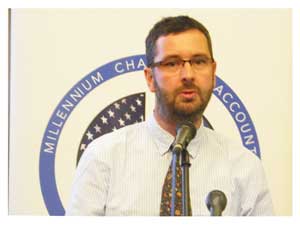
Vigilance combats foot and mouth

Dr. Agnus Cameron, lead consultant of the Northern Communal Areas Foot and Mouth Disease and Lung-sickness Freedom project, presented the key issues at the consultative meeting held in Windhoek (Photograph by Hilma Hashange)
The Syndrome Surveillance System helps the trained farmers to detect early symptoms of foot and mouth disease and lung sickness in livestock as well as to investigate and report such cases in order to prevent a break out.
This is one of the many activities of the Northern Communal Areas Foot and Mouth Disease and Lung-sickness Freedom project. Its overall aim is to contribute to improving rural livelihoods in areas north of the veterinary cordon fence (VCF) through removing current restrictions imposed to farmers living along the red line.
The project, which started in June 2012, held a consultative meeting this week with the Ministry of Agriculture, Water and Forestry’s Directorate of Veterinary Services, on strategies required to ensure the areas north of the red line will meet criteria that will allow the removal of current restrictions at checkpoints along the red line.
During the consultative meeting, Dr. Agnus Cameron, lead consultant of the Northern Communal Areas Foot and Mouth Disease and Lung-sickness Freedom project said the red line does not only prevent people in the northern areas to cross to other places with their cattle but it also carries a historical connotation of division amongst the people living above it.”The main issue is the livelihood of these people. We are not just looking at controlling the disease but also the social problems that come with living above the red line,” Cameron said.
He said the Caprivi Region is the worst hit by Foot and Mouth disease from sources such as buffaloes, cross border theft as well as the uncontrolled movement and purchases of cattle, adding that there was an urgent need to eradicate the problem. In October 2012, the project committee had consultations with the Kunene and Caprivi regional authorities to discuss the prevention of new outbreaks. “We are simply mediators; we try to understand the situation and explain the rules and requirements of the European Union and have ongoing consultations with livestock owners. We can not keep everyone happy but we try to minimise the negative impacts and try to find alternative impacts,” Cameron said regarding the outbreaks of the disease.
According to Cameron, a rapid response to the outbreaks requires a field diagnosis and restriction of movements of livestock at local cross border grazing to prevent any disease entering a disease-free zone He said every community should at least have a trained member who can report any or lack of symptoms in livestock, adding that many vaccination teams spent about six months conducting vaccinations and had little time to identify and focus on new cases. “Community support and collaboration is important. We need abattoir and informal slaughter surveillance to report any suspicicious lung lesions hence livestock should be monitored from border check point to point of slaughter. Wwe need to reassure the communities that they have our full support if ever an outbreak occurs,” Cameron highlighted.
The Northern Communal Areas Foot and Mouth Disease and Lung-sickness Freedom project is designed and funded by the government and the Millennium Challenge Account Namibia under the Livestock Marketing Efficiency Fund. The project’s implementation phase starts early 2014.










































